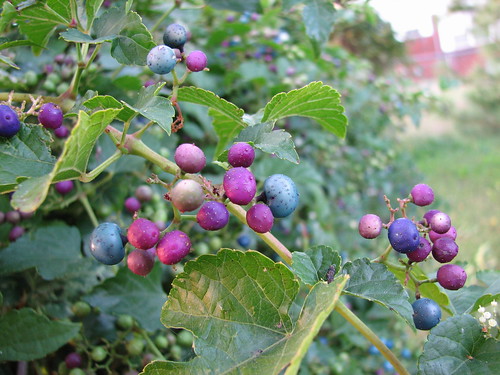
                                               Photo by Jakob.Enos
This Columbus Day weekend TheGardenLady’s daughter came home and wanted to go for a walk. TheGardenLady has her usual 1/2 mile each way walk that goes along a wooded and wildflower route near a stream. Each time, in every season TheGardenLady walks this route, she discovers different and interesting plants or flowers or colorations of leaves. TheGardenLady is not someone who walks blindly. Her favorite mantra is to check every blade of grass along the way. And with another pair of eyes walking alongside, TheGardenLady discovers even more.

When TheGardenLady first moved to this area, one May, she found one of the best stretches for wild strawberries Fragaria virginiana and it was along this route. Because most people who didn’t grow up in a rural area don’t know which foods are edible- even this GardenLady doesn’t know all the edible plants and ALWAYS takes precautions, better to be safe than sorry- this wild strawberry “patch” was a Mother Lode for TheGardenLady.
For those who have tasted them, wild strawberries are the most delicious of all the strawberries. Wild strawberries are one of the fruits TheGardenLady considers ambrosial. But, sad to say, the township mowed this strawberry area down a few years in the running, so that not one wild strawberry plant remains. (Wild strawberry plants do not transplant.)

                                              Photo by weretable
But still there are plants for other animal, bird or insect species to enjoy. Along this walk there is the common milkweed, Asclepias syriaca. There is a rather large clump of them – about a dozen or so plants. Hopefully the township mowers will leave this area unmowed to enable the Monarch butterfly catterpillar to feed on the plant. And on this Columbus Day weekend, the Milkweed seedpods were breaking open and the feathery seed carriers were being blown about. This is one plant that gardeners who want to grow native plants should encourage in your gardens. The plant has a globe lilac to pinkish flower from August through Sept. and an unusually shaped seedpod that cracks open in the fall to allow the seeds to blow. These are easy to grow wildflowers that should bloom in the second year. You can buy the seeds out or gather them now as they are blown about.
The Virginia Creeper was brilliant red as it climbed up the tree trunks; it is one of the earliest plants to turn color in the fall. TheGardenLady’s daughter sometimes confuses Virginia Creeper with poison ivy because poison ivy also turns a brilliant red. But remember that Virginia Creeper has 5 leaves but Poison Ivy only has 3 leaves.
And on this Columbus Day weekend, TheGardenLady’s daughter noticed, among some other plants that TheGardenLady had never in her 30 some odd years of walking this same route, seen. One plant growing there was Ampelopsis brevipendiculata or Porcelain Berry Vine with its lovely pale lilac, purple, blue and green berries. This plant is spread easily by birds and small animals that feed on these colorful berries. Sadly this lovely vine has become a major invasive plant because it spreads so easily and grows so fast that it strangles trees and native wild plants. Because it has some of the prettiest fall berries it was brought to this country to be cultivated around the 1870s as a bedding and landscape plant and in spite of its aggressiveness in some areas, it is still sold by the horticultural trade. Be wary if you fall in love with this vine. Check your state’s invasive plant list before you buy it.

This is just a small listing of all the plants one sees while walking or hiking. Discovery has got to be one of the great joys of life.
